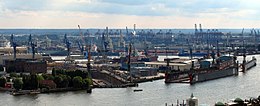Attack on Blohm + Voss on October 13, 1969
The bomb attack on the shipyard of Blohm + Voss in Hamburg district Steinwerder was committed on October 13, 1969th Two supporters of the extra-parliamentary opposition in Hamburg tried to sink the Portuguese corvette João Coutinho , which was still under construction .
prehistory
Blohm + Voss was commissioned to build three corvettes for the Portuguese state. Portugal at that time was a military dictatorship under the dictator António de Oliveira Salazar . The brutal approach, the use of torture and murder against insurgents in their own country, but also in the oppressed colonies, moved many people to view this state negatively. There was great outrage over the construction of the corvettes destined for the colonies, especially among SDS groups. Members of the “Socialist Apprenticeship Center” (SLZ) at Hochallee 21, some of whom worked in the shipyards, organized an information campaign. Leaflets with a message from the Angolan liberation organization MPLA were distributed. At the same time, a letter from Amílcar Cabral for the PAIGC was received by the Hamburg SDS, in which he called for combat in his own country, but explicitly stated that it did not have to be an armed struggle. The Hamburg students then contacted a Dutch Angola committee, which put them in touch with the Portuguese resistance group “League for Revolutionary Unity and Action” (LUAR). There was a meeting in Paris at which after a while an offer of 20 kilograms of explosives was made. After returning to Hamburg two weeks later, the students were given a key for a locker in Hamburg's main train station, in which the explosives were stored.
The attack
After a test of a small part of the explosives at the Höltigbaum military training area , the two assassins built the bomb they would later use from a plastic bucket and an alarm clock, among other things. They got a call and got ready to commit the assassination attempt. They went to the yard through a hole in the fence. They assumed the guards were moving from the post on the night shift. But when the guard did not do this, they improvised and deposited the explosive device between a barge and the corvette in a water depth of two meters and not on the corvette itself. They set the time fuse for 6:30 a.m. and called at 6:13 a.m. the police station so that the yard would be evacuated and no people would be injured. At 06:15 and 06:20 which was additionally plant security called. The bomb detonated at 6:32 a.m. Debris flew up to 150 meters. The completion of the ship was delayed by eight months. The João Coutinho had a displacement of 1380 tons and served from 1970 to 2014.
Aftermath
Contrary to what the bombers had hoped, there was hardly any coverage of the attack in the German media, while there were more detailed reports on it in the Netherlands . It was planned to distribute leaflets for posting, but this did not happen. The two assassins traveled to Morocco after the attack and stayed there until Christmas. According to their own statements, they were followed by the police after they returned home, but they were never interrogated.
After the Carnation Revolution in Portugal, the two Portuguese revolutionaries Camilo Mortágua and Hermínio da Palma Inácio received the highest Portuguese medal, the Ordem da Liberdade . It was they who obtained the explosives for the students.
Individual evidence
- ↑ a b c Attack on Blohm + Voss: Why these men break their silence after 51 years. In: MOPO. October 21, 2020, accessed October 23, 2021 .
- ^ Wolfgang Kraushaar : Anti-colonial attack in Hamburg: cleared up after 50 years . In: The daily newspaper: taz . October 10, 2019, ISSN 0931-9085 ( taz.de [accessed on October 23, 2021]).

